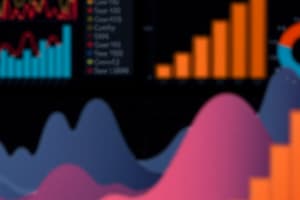Podcast
Questions and Answers
What is the primary purpose of Exploratory Data Analysis (EDA)?
What is the primary purpose of Exploratory Data Analysis (EDA)?
- To discover patterns and check assumptions using summary statistics and graphical representations (correct)
- To predict future trends in the given data
- To perform advanced statistical modeling on the dataset
- To clean and preprocess the data for machine learning tasks
What type of analysis involves analyzing an attribute with the target attribute?
What type of analysis involves analyzing an attribute with the target attribute?
- Bivariate analysis (correct)
- Multivariate analysis
- Univariate analysis
- Correlation analysis
What is the primary purpose of Python Seaborn library?
What is the primary purpose of Python Seaborn library?
- Data preprocessing for exploratory data analysis
- Statistical modeling for predictive analytics
- Data cleaning and imputation
- Data visualization for data science and machine learning tasks (correct)
What type of approach uses functions such as shape, summary, describe, isnull, info, datatypes, etc.?
What type of approach uses functions such as shape, summary, describe, isnull, info, datatypes, etc.?
What does EDA provide in-depth insights into?
What does EDA provide in-depth insights into?
Which type of analysis involves analyzing a single attribute?
Which type of analysis involves analyzing a single attribute?
What does EDA help to find in the given data?
What does EDA help to find in the given data?
Which library is commonly used for data visualization and machine learning tasks in Python?
Which library is commonly used for data visualization and machine learning tasks in Python?
What is the primary focus of Exploratory Data Analysis (EDA)?
What is the primary focus of Exploratory Data Analysis (EDA)?
Which type of approach uses functions such as shape, summary, describe, isnull, info, datatypes, etc.?
Which type of approach uses functions such as shape, summary, describe, isnull, info, datatypes, etc.?
Flashcards
Exploratory Data Analysis (EDA) purpose
Exploratory Data Analysis (EDA) purpose
To uncover patterns and validate assumptions in data using summary statistics and graphs.
Bivariate Analysis
Bivariate Analysis
Analyzing the relationship between two attributes.
Seaborn Library purpose
Seaborn Library purpose
Creates visualizations for data analysis.
Non-graphical Approach
Non-graphical Approach
Signup and view all the flashcards
EDA insights
EDA insights
Signup and view all the flashcards
Univariate Analysis
Univariate Analysis
Signup and view all the flashcards
EDA data patterns
EDA data patterns
Signup and view all the flashcards
Python Data Visualization
Python Data Visualization
Signup and view all the flashcards
Primary Focus of EDA
Primary Focus of EDA
Signup and view all the flashcards
Descriptive functions purpose
Descriptive functions purpose
Signup and view all the flashcards
Study Notes
Exploratory Data Analysis (EDA)
- Primary purpose of EDA is to gain a deep understanding of the structure and patterns in the data
- Provides in-depth insights into the underlying characteristics of the data
- Helps to find patterns, outliers, and correlations within the data
- Primary focus of EDA is to summarize and describe the main features of the data
Analysis Types
- Univariate analysis involves analyzing a single attribute
- Bivariate analysis involves analyzing an attribute with the target attribute
Data Analysis Approach
- Involves using functions such as shape, summary, describe, isnull, info, datatypes, etc. to gain insights into the data
Python Libraries
- Seaborn library is primarily used for data visualization
- Python libraries such as Seaborn and Matplotlib are commonly used for data visualization and machine learning tasks in Python
Studying That Suits You
Use AI to generate personalized quizzes and flashcards to suit your learning preferences.




